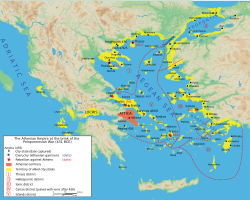|
Classical Athens
The city of Athens (Ancient Greek: Ἀθῆναι, Athênai [a.tʰɛ̂ː.nai̯]; Modern Greek: Αθήναι, Athine [a.ˈθi.ne̞] or, more commonly and in singular, Αθήνα, Athina [a.'θi.na]) during the classical period of ancient Greece (480–323 BC)[1] was the major urban centre of the notable polis (city-state) of the same name, located in Attica, Greece, leading the Delian League in the Peloponnesian War against Sparta and the Peloponnesian League. Athenian democracy was established in 508 BC under Cleisthenes following the tyranny of Isagoras. This system remained remarkably stable, and with a few brief interruptions, it remained in place for 180 years, until 322 BC (aftermath of Lamian War). The peak of Athenian hegemony was achieved in the 440s to 430s BC, known as the Age of Pericles. In the classical period, Athens was a centre for the arts, learning, and philosophy, the home of Plato's Academy and Aristotle's Lyceum,[2][3] Athens was also the birthplace of Socrates, Plato, Pericles, Aristophanes, Sophocles, and many other prominent philosophers, writers, and politicians of the ancient world. It is widely referred to as the cradle of Western Civilization, and the birthplace of democracy,[4] largely due to the impact of its cultural and political achievements during the 5th and 4th centuries BC on the rest of the then-known European continent.[5] HistoryRise to power (508–448 BC)Hippias, son of Peisistratus, had ruled Athens jointly with his brother, Hipparchus, from the death of Peisistratus in about 527. Following the assassination of Hipparchus in about 514, Hippias took on sole rule, and in response to the loss of his brother, became a worse leader who was increasingly disliked. Hippias exiled 700 of the Athenian noble families, amongst them Cleisthenes' family, the Alchmaeonids. Upon their exile, they went to Delphi, and Herodotus[6] says they bribed the Pythia always to tell visiting Spartans that they should invade Attica and overthrow Hippias. That supposedly worked after a number of times, and Cleomenes I led a Spartan force to overthrow Hippias, which succeeded, and instated an oligarchy. Cleisthenes disliked the Spartan rule, along with many other Athenians, and so made his own bid for power. The result was democracy in Athens, but considering Cleisthenes' motivation for using the people to gain power, as without their support, he would have been defeated, and so Athenian democracy may be tainted by the fact its creation served greatly the man who created it. The reforms of Cleisthenes replaced the traditional four Ionic "tribes" (phyle) with ten new ones, named after legendary heroes of Greece and having no class basis, which acted as electorates. Each tribe was in turn divided into three trittyes (one from the coast; one from the city and one from the inland divisions), while each trittys had one or more demes, depending on their population, which became the basis of local government. The tribes each selected fifty members by lot for the Boule, the council that governed Athens on a day-to-day basis. The public opinion of voters could be influenced by the political satires written by the comic poets and performed in the city theaters.[7] The Assembly or Ecclesia was open to all full citizens and was both a legislature and a supreme court, except in murder cases and religious matters, which became the only remaining functions of the Areopagus. Most offices were filled by lot, although the ten strategoi (generals) were elected. 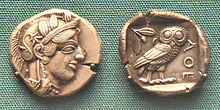 The silver mines of Laurion contributed significantly to the development of Athens in the 5th century BC, when the Athenians learned to prospect, treat, and refine the ore and used the proceeds to build a massive fleet, at the instigation of Themistocles.[8] In 499 BC, Athens sent troops to aid the Ionian Greeks of Asia Minor, who were rebelling against the Persian Empire (see Ionian Revolt). That provoked two Persian invasions of Greece, both of which were repelled under the leadership of the soldier-statesmen Miltiades and Themistocles (see Persian Wars). In 490 the Athenians, led by Miltiades, prevented the first invasion of the Persians, guided by king Darius I, at the Battle of Marathon. In 480 the Persians returned under a new ruler, Xerxes I. The Hellenic League led by the Spartan King Leonidas led 7,000 men to hold the narrow passageway of Thermopylae against the 100,000–250,000 army of Xerxes, during which Leonidas and 300 other Spartan elites were killed. Simultaneously the Athenians led an indecisive naval battle off Artemisium. However, that delaying action was not enough to discourage the Persian advance, which soon marched through Boeotia, setting up Thebes as their base of operations, and entered southern Greece. That forced the Athenians to evacuate Athens, which was taken by the Persians, and seek the protection of their fleet. Subsequently, the Athenians and their allies, led by Themistocles, defeated the Persian navy at sea in the Battle of Salamis. Xerxes had built himself a throne on the coast in order to see the Greeks defeated. Instead, the Persians were routed. Sparta's hegemony was passing to Athens, and it was Athens that took the war to Asia Minor. The victories enabled it to bring most of the Aegean and many other parts of Greece together in the Delian League, an Athenian-dominated alliance. Athenian hegemony (448–430 BC)Pericles – an Athenian general, politician and orator – distinguished himself above the other personalities of the era, men who excelled in politics, philosophy, architecture, sculpture, history and literature. He fostered arts and literature and gave to Athens a splendor which would never return throughout its history. He executed a large number of public works projects and improved the life of the citizens. Hence, this period is often referred to as "Age of Pericles."[9] Silver mined in Laurium in southeastern Attica contributed greatly to the prosperity of this Athenian Golden Age. During the time of the ascendancy of Ephialtes as leader of the democratic faction, Pericles was his deputy. When Ephialtes was assassinated by personal enemies, Pericles stepped in and was elected general, or strategos, in 445 BC; a post he held continuously until his death in 429 BC, always by election of the Athenian Assembly. The Parthenon, a lavishly decorated temple to the goddess Athena, was constructed under the administration of Pericles.[10] Peloponnesian War (431–404 BC)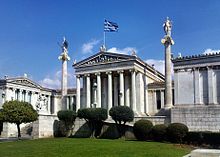 Resentment by other cities at the hegemony of Athens led to the Peloponnesian War in 431, which pitted Athens and her increasingly rebellious sea empire against a coalition of land-based states led by Sparta. The conflict marked the end of Athenian command of the sea. The war between Athens and the city-state Sparta ended with an Athenian defeat after Sparta started its own navy. Athenian democracy was briefly overthrown by the coup of 411, brought about because of its poor handling of the war, but it was quickly restored. The war ended with the complete defeat of Athens in 404. Since the defeat was largely blamed on democratic politicians such as Cleon and Cleophon, there was a brief reaction against democracy, aided by the Spartan army (the rule of the Thirty Tyrants). In 403, democracy was restored by Thrasybulus and an amnesty declared. Corinthian War and the Second Athenian League (395–355 BC)Sparta's former allies soon turned against her due to her imperialist policies, and Athens's former enemies, Thebes and Corinth, became her allies. Argos, Thebes and Corinth, allied with Athens, fought against Sparta in the Corinthian War of 395–387 BC. In 378, the attempt of the Spartan commander Sphodrias to capture Piraeus by surprise triggered Athens to establish the Second Athenian League. Finally Thebes defeated Sparta in 371 in the Battle of Leuctra. However, other Greek cities, including Athens, turned against Thebes, and its dominance was brought to an end at the Battle of Mantinea (362 BC) with the death of its leader, the military genius Epaminondas. Athens and Macedon (355–322 BC)By mid century, however, the northern Greek kingdom of Macedon was becoming dominant in Athenian affairs. In 338 BC the armies of Philip II defeated Athens at the Battle of Chaeronea, effectively limiting Athenian independence. During the winter of 338–37 BC Macedonia, Athens and other Greek states became part of the League of Corinth. Further, the conquests of his son, Alexander the Great, widened Greek horizons and made the traditional Greek city state obsolete. Antipater dissolved the Athenian government and established a plutocratic system in 322 BC (see Lamian War and Demetrius Phalereus). Athens remained a wealthy city with a brilliant cultural life, but ceased to be an independent power. The cityOverview Athens was in Attica, about 30 stadia from the sea, on the southwest slope of Mount Lycabettus, between the small rivers Cephissus to the west, Ilissos to the south, and the Eridanos to the north, the latter of which flowed through the town. The walled city measured about 1.5 km (0.93 mi) in diameter, although at its peak the city had suburbs extending well beyond these walls. The Acropolis was just south of the centre of this walled area. The city was burnt by Xerxes in 480 BC, but was soon rebuilt under the administration of Themistocles, and was adorned with public buildings by Cimon and especially by Pericles, in whose time (461–429 BC) it reached its greatest splendour. Its beauty was chiefly due to its public buildings, for the private houses were mostly insignificant, and its streets badly laid out. Towards the end of the Peloponnesian War, it contained more than 10,000 houses,[11] which at a rate of 12 inhabitants to a house would give a population of 120,000, though some writers make the inhabitants as many as 180,000. Athens consisted of two distinct parts:
City walls The city was surrounded by defensive walls from the Bronze Age and they were rebuilt and extended over the centuries. In addition the Long Walls consisted of two parallel walls leading to Piraeus, 40 stadia long (4.5 miles, 7 km), running parallel to each other, with a narrow passage between them and, furthermore, a wall to Phalerum on the east, 35 stadia long (4 miles, 6.5 km). There were therefore three long walls in all; but the name Long Walls seems to have been confined to the two leading to the Piraeus, while the one leading to Phalerum was called the Phalerian Wall. The entire circuit of the walls was 174.5 stadia (nearly 22 miles, 35 km), of which 43 stadia (5.5 miles, 9 km) belonged to the city, 75 stadia (9.5 miles, 15 km) to the long walls, and 56.5 stadia (7 miles, 11 km) to Piraeus, Munichia, and Phalerum. GatesThere were many gates, among the more important there were:
Acropolis (upper city)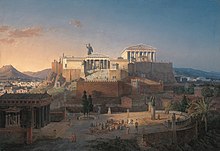 The Acropolis, also called Cecropia from its reputed founder, Cecrops, was a steep rock in the middle of the city, about 50 meters high, 350 meters long, and 150 meters wide; its sides were naturally scarped on all sides except the west end. It was originally surrounded by an ancient Cyclopean wall said to have been built by the Pelasgians. At the time of the Peloponnesian war only the north part of this wall remained, and this portion was still called the Pelasgic Wall; while the south part which had been rebuilt by Cimon, was called the Cimonian Wall. On the west end of the Acropolis, where access is alone practicable, were the magnificent Propylaea, "the Entrances", built by Pericles, before the right wing of which was the small Temple of Athena Nike. The summit of the Acropolis was covered with temples, statues of bronze and marble, and various other works of art. Of the temples, the grandest was the Parthenon, sacred to the "Virgin" goddess Athena; and north of the Parthenon was the magnificent Erechtheion, containing three separate temples, one to Athena Polias, or the "Protectress of the State", the Erechtheion proper, or sanctuary of Erechtheus, and the Pandroseion, or sanctuary of Pandrosos, the daughter of Cecrops. Between the Parthenon and Erechtheion was the colossal Statue of Athena Promachos, or the "Fighter in the Front", whose helmet and spear was the first object on the Acropolis visible from the sea. Agora (lower city)The lower city was built in the plain around the Acropolis, but this plain also contained several hills, especially in the southwest part. On the west side the walls embraced the Hill of the Nymphs and the Pnyx, and to the southeast they ran along beside the Ilissos. Districts
Hills
StreetsAmong the more important streets, there were:
Public buildings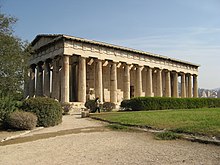
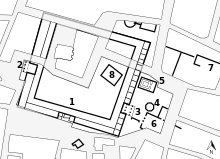

Suburbs
Culture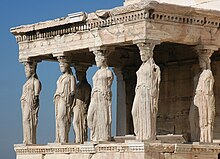 The period from the end of the Persian Wars to the Macedonian conquest marked the zenith of Athens as a center of literature, philosophy (see Greek philosophy) and the arts (see Greek theatre). Some of the most important figures of Western cultural and intellectual history lived in Athens during this period: the dramatists Aeschylus, Aristophanes, Euripides and Sophocles, the philosophers Aristotle, Plato, and Socrates, the historians Herodotus, Thucydides and Xenophon, the poet Simonides and the sculptor Phidias. The leading statesman of this period was Pericles, who used the tribute paid by the members of the Delian League to build the Parthenon and other great monuments of classical Athens. The city became, in Pericles's words, an education for Hellas (usually quoted as "the school of Hellas [Greece].")[12] See also
References
|
|||||||||||||||||||||||||||||||||||||||||||||||||||||||||||||||||||||||||

